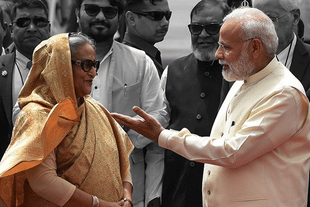Politics
India Needs A Post-CAA Outreach To Miffed Bangladesh On Migrants
R Jagannathan
Mar 16, 2020, 01:20 PM | Updated 01:22 PM IST
Save & read from anywhere!
Bookmark stories for easy access on any device or the Swarajya app.


The Prime Minister’s outreach to leaders of the South Asian Association for Regional Cooperation (SAARC) on tackling the Covid-19 pandemic is indicative of the proactive nature of his diplomatic efforts.
Apart from proposing an emergency fund to jointly tackle the spread of the disease, he pointed out the obvious in his video-conference with SAARC leaders yesterday (15 March): that the region is home to one-fifth of humanity, and healthcare facilities are limited. So, the challenge is enormous.
The Times of India quotes Narendra Modi thus: “It (South Asia) is densely populated. As developing countries, all of us have challenges in terms of facilities. Our people-to-people ties are ancient, and our societies are inter-connected. Therefore, we must prepare together, we must act together, and we must all succeed together.”
The Pakistani effort to queer the pitch by bringing in Kashmir was politely side-stepped.
What went unstated in the video-conference was the larger reality of porous borders. But for this, it would have been easier to contain the spread of the disease.
Covids may come and go, but Modi really needs to address the larger bone of contention between SAARC nations, which is free movement of people across borders. Thanks to persecution of Hindus and other minorities in Pakistan and Bangladesh, and Tamils in Sri Lanka, India has had to periodically allow for large influxes of people from its neighbour, most recently with the passing of the Citizenship Amendment Act 2019 (CAA).
CAA has angered Bangladesh and Afghanistan, both countries where the leadership has been friendly to India in recent years. While people flows from Afghanistan are limited, Bangladesh has been a major source of illegal immigration, both due to the persecution of minorities in that country, and the arrival of Bangladeshi Muslims seeking better livelihoods.
CAA has thus drawn protests not only from Muslims inside India, who have wrongly assumed that the law targets them, but also in Bangladesh.
After the CAA law was passed, diplomatic ties have gone south, with Bangladesh repeatedly cancelling scheduled visits by its ministers to India. Modi’s own trip to Dhaka to celebrate Sheikh Mujibur Rehman’s birth centenary, the current Prime Minister’s late father, has been cancelled, reportedly due to the Covid-19 scare. But the new frostiness in the relationship cannot have helped.
Clearly, the Indian government needs to plan a new outreach to Bangladesh not only to smoothen ruffled feathers but also to prepare the ground for a more enduring agreement on people movements across a porous border.
Some aspects of the India-Nepal treaty that allows citizens to move freely across the border are worth offering as part of a deal with Bangladesh.
First, India should offer Bangladeshi citizens the option to work in India, but with the proviso that they return after specified periods to their home country, so that no citizenship rights are invoked. Work permits ought to be liberal.
Second, India can, and must, clearly offer citizenship rights to Hindus and minorities who want to move to India. Those who choose to stay back, or want to return to Bangladesh, ought to be guaranteed freedom of not only their religious identities, but protection of life and limb.
This would be somewhat like the Nehru-Liaquat pact where each country guarantees the protection of its minorities, but applied in a limited way to Bangladeshi and Indian citizens residing in each other’s territories. Investments and natural persons moving across borders to run businesses ought to be protected too.
Bangladesh needs to know that there would be no need for a CAA if it can protect its own minorities well. Equally, it can be given the assurance that its people can work here, as long as they don’t claim citizenship rights. This eases the economic burden on Bangladesh, but does not impose a demographic crisis in India’s vulnerable north-east by excess illegal migration.
The core message should be: we are okay with porous borders and legal work-related migration, but not illegal infiltration.
Jagannathan is former Editorial Director, Swarajya. He tweets at @TheJaggi.





